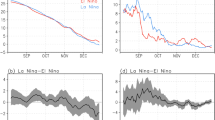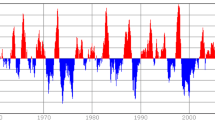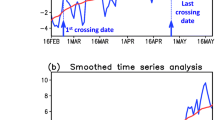Abstract
The dates of the transition between winter and summer (W2S) and between summer and winter (S2W) regional-scale atmospheric regimes have been defined using daily weather types above and around the Caribbean basin from 1979 to 2017. The uncertainties due to either the use of two different reanalyses (i.e., NCEP-DOE and ERA-Interim) or the parametrization used for the definition of the transition dates have typically a small impact on the interannual variability of the seasonal transitions. When both reanalyses are considered together, the average W2S transition date occurs, on average, on May 13 (with a standard deviation of 9 days) while the S2W transition date occurs, on average, on October 26 (with a standard deviation of 12 days). The atmospheric characteristics associated with both transitions reveal asymmetries in the annual cycle. The W2S transition is rather abrupt and near-synchronous to a rather sharp increase of rainfall, propagating from Central America to the NE of the Caribbean basin, and a weakening of the Caribbean Low Level Jet. The W2S transition is also not preceded by any significant sea surface temperature (SST) anomalies either in the tropical North Atlantic or the Eastern Pacific. On the other hand, the S2W transition is overall smoother, and anomalously warm (cold) SST over the Caribbean Sea and Gulf of Mexico (Eastern Pacific) during the boreal summer are usually related to a delayed transition (and vice versa). The interannual variations of S2W and W2S transitions are mostly independent to each other. The potential and real-time predictability of the W2S transition is explored using a subseasonal-to-seasonal prediction ensemble (11 runs from 1998 to 2017) from the ECMWF model. Its skill is close to zero with a lead time longer than 15–20 days, confirming the weak impact of the antecedent SST upon the W2S transition. The skill suddenly increases from late April, 2–3 weeks only before the mean W2S transition date. It suggests that some atmospheric forcing, operating from synoptic to intra-seasonal time scale, plays a role, but it seems barely related to any occurrence, or sequence, of specific weather types.









Similar content being viewed by others
References
Alexander MA, Bladé I, Newman M, Lazante JR, Lau N-C, Scott JD (2002) The atmospheric bridge: the influence of ENSO teleconnections on air-sea interaction over global oceans. J Clim 15:2205–2231. https://doi.org/10.1175/1520-0442(2002)015<2205:TABTIO>2.0.CO;2
Allen T, Mapes BE (2017) The late spring Caribbean rain-belt: climatology and dynamics. Int J Climatol 37:4981–4993. https://doi.org/10.1002/joc.5136
Amador JA (2008) The intra-Americas sea low-level jet. Ann NY Acad Sci 1146:153–188. https://doi.org/10.1196/annals.1446.012
Angeles ME, González JE, Ramírez-Beltrán ND, Tepley CA, Comarazamy DE (2010) Origins of the Caribbean rainfall bimodal behavior. J Geophys Res 115:D11106. https://doi.org/10.1029/2009jD012990
Ashby SA, Taylor MA, Chen AA (2005) Statistical models for predicting rainfall in the Caribbean. Theor Appl Climatol 82:65–80. https://doi.org/10.1007/s00704-004-0118-8
Ashok K, Behera SK, Rao SA, Weng H, Yamagata T (2007) El Niño Modoki and its possible teleconnection. J Geophys Res 112:C11007. https://doi.org/10.1029/2006JC003798
Ashouri H, Hsu K, Sorooshian S, Braithwaite DK, Knapp KR, Cecil LD, Nelson BR, Prat OP (2015) PERSIANN-CDR: daily precipitation climate data record from multisatellite observations for hydrological and climate studies. Bull Am Meteorol Soc 96:69–83. https://doi.org/10.1175/BAMS-D-13-00068.1
Blume H (1974) The Caribbean Islands. Longman, London (ISBN 978-0582481640)
Bombardi RJ, Moron V, Goodnight JS (2020) Detection, variability, and predictability of monsoon onset and withdrawal dates: A review. Int J Climatol 40:641–667. https://doi.org/10.1002/joc.6264
Carlson TN, Prospero JM (1972) The large-scale movement of Saharan air outbreaks over the northern equatorial Atlantic. J Appl Meteor 11:283–297. https://doi.org/10.1175/1520-0450(1972)011<0283:TLSMOS>2.0.CO;2
Chadee XT, Clarke RM (2015) Daily near-surface large-scale atmospheric circulation patterns over the wider Caribbean. Clim Dyn 44:2927–2946. https://doi.org/10.1007/s00382-015-2621-2
Chen AA, Taylor MA (2002) Investigating the link between early season Caribbean rainfall and the El Niño \(+ 1\) year. Int J Climatol 22:87–106. https://doi.org/10.1002/joc.711
Cook KH, Vizy EK (2010) Hydrodynamics of the Caribbean low-level jet and its relationship to precipitation. J Clim 23:1477–1494. https://doi.org/10.1175/2009JCLI3210.1
Curtis S (2013) Daily precipitation distributions over the intra-Americas sea and their interannual variability. Atmósfera 26:243–259. https://doi.org/10.1016/S0187-6236(13)71074-9
Curtis S, Gamble DW (2008) Regional variations of the Caribbean mid-summer drought. Theor Appl Climatol 94:25–34. https://doi.org/10.1007/s00704-007-0342-0
Diday E, Simon JC (1976) Clustering analysis. In: Fu KS (ed) Digital pattern recognition. Communication and cybernetics, vol 10. Springer, Berlin, pp 47–94. https://doi.org/10.1007/978-3-642-96303-2_3
Douglas MW, Maddox RA, Howard K, Reyes S (1993) The Mexican monsoon. J Clim 6:1665–1677. https://doi.org/10.1175/1520-0442(1993)006<1665:TMM>2.0.CO;2
Dunion JP (2011) Rewritting the climatology of the tropical North Atlantic and Caribbean sea atmosphere. J Clim 24:893–908. https://doi.org/10.1175/2010JCLI3496.1
Enfield DB (1996) Relationships of inter-american rainfall to tropical Atlantic and Pacific SST variability. Geophys Res Lett 23:3305–3308. https://doi.org/10.1029/96GL03231
Enfield DB, Alfaro EJ (1999) The dependence of Caribbean rainfall on the interaction of the tropical Atlantic and Pacific Oceans. J Clim 12:2093–2103. https://doi.org/10.1175/1520-0442(1999)012<2093:TDOCRO>2.0.CO;2
Enfield DB, Mayer DA (1997) Tropical Atlantic sea surface temperature variability and its relation to El Niño-Southern Oscillation. J Geophys Res 102:929–945. https://doi.org/10.1029/96JC03296
Funk CC, Peterson PJ, Landsfeld MF, Pedreros DH, Verdin JP, Rowland JD, Romero BE, Husak GJ, Michaelsen JC, Verdin AP (2014) A quasi-global precipitation time series for drought monitoring. US Geological Survey Data Series 832, 4 pages. https://doi.org/10.3133/ds832
Gamble DW, Curtis S (2008) Caribbean precipitation: review, model and prospect. Progress Phys Geography 32:265–276. https://doi.org/10.1177/0309133308096027
García-Serrano J, Cassou C, Douville H, Giannini A, Doblas-Reyes FJ (2017) Revisiting the ENSO teleconnection to the tropical North Atlantic. J Clim 30:6945–6957. https://doi.org/10.1175/JCLI-D-16-0641.1
Ghil M, Robertson AW (2002) “Waves” vs. “particles” in the atmosphere’s phase space: a pathway to long-range forecasting? Proc Natl Acad Sci USA 99:2493–2500. https://doi.org/10.1073/pnas.012580899
Giannini A, Chiang JCH, Cane MA, Kushnir Y, Seager R (2001) The ENSO teleconnection to the tropical Atlantic ocean: contributions of the remote and local SSTs to rainfall variability in the tropical Americas. J Clim 14:4530–4544. https://doi.org/10.1175/1520-0442(2001)014<4530:TETTTT>2.0.CO;2
Giannini A, Kushnir Y, Cane MA (2000) Interannual variability of Caribbean rainfall, ENSO and the Atlantic Ocean. J Clim 13:297–311. https://doi.org/10.1175/1520-0442(2000)013<0297:IVOCRE>2.0.CO;2
Gloneck GFV, McCullagh P (1995) Multivariate logistic models. J R Stat Soc B57:533–546. https://doi.org/10.1111/j.2517-6161.1995.tb02046.x
González M, Barros V, Doyle M (2002) Relation between the onset and end of the South American summer monsoon and rainfall in subtropical South America. Climate Res 21:141–155. https://doi.org/10.3354/cr021141
Gouirand I, Jury MR, Sing B (2012) An analysis of low- and high-frequency summer climate variability around the Caribbean Antilles. J Clim 25:3942–3952. https://doi.org/10.1175/JCLI-D-11-00269.1
Gouirand I, Moron V (2003) Variability of the impact of El Niño-Southern oscillation on sea-level pressure anomalies over the North Atlantic in January to March (1874–1996). Int J Climatol 23:1549–1566. https://doi.org/10.1002/joc.963
Gouirand I, Moron V, Hu Z-Z, Jha B (2014) Influence of warm pool and cold tongue El Niños on the following Caribbean rainy season rainfall. Clim Dyn 42:919–929. https://doi.org/10.1007/s00382-013-1753-5
Gu G, Adler RF (2006) Interannual rainfall variability in the tropical Atlantic region. J Geophys Res 111:D02106. https://doi.org/10.1029/2005JD005944
Guanche Y, Mínguez R, Méndez FJ (2014) Autoregressive logistic regression applied to atmospheric circulation patterns. Clim Dyn 42:537–552. https://doi.org/10.1007/s00382-013-1690-3
Herrera E, Ault T (2017) Insights from a new high-resolution drought atlas for the Caribbean spanning 1950–2016. J Clim 30:7801–7825. https://doi.org/10.1175/JCLI-D-16-0838.1
Herrera E, Magaña V, Caetano E (2014) Air-sea interactions and dynamical processes associated with the midsummer drought. Int J Climatol 35:1569–1578. https://doi.org/10.1002/joc.4077
Higgins RW, Yao Y, Wang XL (1997) Influence of the North American monsoon system on the U.S. summer precipitation regime. J Clim 10:2600–2622. https://doi.org/10.1175/1520-0442(1997)010<2600:IOTNAM>2.0.CO;2
Hu Z-Z, Kumar A, Huang B, Xue Y, Wang W, Jha B (2011) Persistent atmospheric and oceanic anomalies in the North Atlantic from summer 2009 to summer 2010. J Clim 24:5812–5830. https://doi.org/10.1175/2011JCLI4213.1
Huffman GJ, Adler RF, Boivin DT, Gu G (2009) Improving the global precipitation record: GPCP version 2.1. Geophys Res Lett 36:L17808. https://doi.org/10.1029/2009GL040000
Huffman GJ, Adler RF, Morissey MM, Boivin DT, Curtis S, Joyce R, MacGavock B, Susskind J (2001) Global precipitation at one-degree daily resolution from multisatellite observations. J Hydrometeor 2:36–50. https://doi.org/10.1175/1525-7541(2001)002<0036:GPAODD>2.0.CO;2
Inoue M, Handoh IC, Bigg GR (2002) Bimodal distribution of tropical cyclogenesis in the Caribbean: characteristics and environmental factors. J Clim 15:2897–2905. https://doi.org/10.1175/1520-0442(2002)015<2897:BDOTCI>2.0.CO;2
Janicot S, Moron V, Fontaine B (1996) Sahel droughts and ENSO dynamics. Geophys Res Lett 23:515–518. https://doi.org/10.1029/96GL00246
Jury MR (2009) An intercomparison of observational, reanalysis, satellite, and coupled model data on mean rainfall in the Caribbean. J Hydrometeor 10:413–430. https://doi.org/10.1175/2008JHM1054.1
Jury MR, Malmgren BA, Winter A (2007) Subregional precipitation climate of the Caribbean and relationships with ENSO and NAO. J Geophys Res 112:D16107. https://doi.org/10.1029/2006JD007541
Kalnay E, Kanamitsu M, Kistler R, Collins W, Deaven D, Gandin L, Iredell M, Saha S, White G, Woollen J, Zhu Y, Chelliah M, Ebisuzaki W, Higgins W, Janowiak J, Mo KC, Ropelewski C, Wang J, Leetmaa A, Reynolds R, Jenne R, Joseph D (1996) The NCEP/NCAR 40-year reanalysis project. Bull Amer Meteor Soc 77:437–472. https://doi.org/10.1175/1520-0477(1996)077<0437:TNYRP>2.0.CO;2
Kanamitsu M, Ebisuzaki W, Woollen J, Yang S, Hnilo JJ, Fiorino M, Potter GL (2002) NCEP-DOE AMIP-II reanalysis (R-2). Bull Amer Meteor Soc 83:1631–1643. https://doi.org/10.1175/BAMS-83-11-1631
Karnauskas KB, Seager R, Giannini A, Busalacchi AJ (2013) A simple mechanism for the climatological midsummer drought along the Pacific coast of Central America. Atmósfera 26:261–281. https://doi.org/10.1016/S0187-6236(13)71075-0
Kousky VE (1988) Pentad outgoing longwave radiation climatology for the south american sector. Revista Brasileira de Meteorologia 3:217–231 http://www.rbmet.org.br/port/revista/revista_artigo.php?id_artigo=394
Liebmann B, Smith CA (1996) Description of a complete (interpolated) outgoing longwave radiation dataset. Bull Amer Meteor Soc 77:1275–1277. https://doi.org/10.1175/1520-0477-77.6.1274
Liebmann B, Camargo SJ, Seth A, Marengo JA, Carvhalo LMV, Allured D, Fu R, Vera CS (2007) Onset and end of the rainy season in South America in observations and the ECHAM 4.5 atmospheric general circulation model. J Clim 20:2037–2050. https://doi.org/10.1175/JCLI4122.1
Magana V, Amador J, Medina S (1999) The midsummer drought over Mexico and Central America. J Clim 12:1577–1588. https://doi.org/10.1175/1520-0442(1999)012<1577:TMDOMA>2.0.CO;2
Maldonado T, Rutgersson A, Alfaro E, Amador J, Claremar B (2006) Interannual variability of the midsummer drought in Central America and the connection with sea surface temperatures. Adv Geosci 42:35–50. https://doi.org/10.5194/adgeo-42-35-2016
Mapes BE, Buenning N, Kang I-S, Kiladis GN, Schultz DM, Weickmann KM (2004) Strides, steps and stumbles in the march of the seasons. (unpublished manuscript); https://www.semanticscholar.org/paper/Strides,-steps-and-stumbles-in-the-march-of-the-Mapes-Buenning/7696a2713a971d08f9abe4180a868d8ed5ff3a9c. Accessed 22 December 2019
Marengo JA, Liebman B, Kousky VE, Filizola NP, Wainer IC (2001) Onset and end of the rainy season in the Brazilian Amazon basin. J Clim 14:833–852. https://doi.org/10.1175/1520-0442(2001)014<0833:OAEOTR>2.0.CO;2
Marteau R, Moron V, Philippon N (2009) Spatial coherence of monsoon onset over western and central Sahel (1950–2000). J Clim 22:1313–1324. https://doi.org/10.1175/2008JCLI2383.1
Martinez C, Goddard L, Kushnir Y, Ting M (2019) Seasonal climatology and dynamical mechanisms of rainfall in the Caribbean. Clim Dyn 53:825–846. https://doi.org/10.1007/s00382-019-04616-4
May DA, Parmeter MM, Olszewski DS, McKenzie BD (1998) Operational processing of satellite sea surface temperature retrievals at the Naval Oceanographic Office. Bull Am Meteorol Soc 79:397–407. https://doi.org/10.1175/1520-0477(1998)079<0397:OPOSSS>2.0.CO;2
Mestas-Nuñez AM, Enfield DB, Zhang C (2007) Water vapor fluxes over the intra-Americas sea: seasonal and interannual variability and association with rainfall. J Clim 20:1910–1922. https://doi.org/10.1175/JCLI4096.1
Michelangeli P-A, Vautard R, Legras B (1995) Weather regimes: rAecurrence and quasi-stationarity. J Atmos Sci 52:1237–1256. https://doi.org/10.1175/1520-0469(1995)052<1237:WRRAQS>2.0.CO;2
Moron V, Gouirand I (2003) Seasonal modulation of the El Niño southern oscillation relationship with sea level pressure anomalies over the North Atlantic in October-March 1873–1996. Int J Climatol 23:143–155. https://doi.org/10.1002/joc.868
Moron V, Gouirand I, Taylor M (2015a) Weather types across the Caribbean basin and their relationship with rainfall and sea surface temperature. Clim Dyn 47:601–621. https://doi.org/10.1007/s00382-015-2858-9
Moron V, Frelat R, Jean-Jeune PK, Gaucherel C (2015b) Interannual and intra-annual variability of rainfall in Haiti (1905–2005). Clim Dyn 45:915–932. https://doi.org/10.1007/s00382-014-2326-y
Moron V, Robertson AW (2014) Interannual variability of Indian summer monsoon rainfall onset date at local scale. Int J Climatol 34:1050–1061. https://doi.org/10.1002/joc.3745
Moron V, Robertson AW (2020) Tropical seasonal-to-subseasonal predictability types. npj Clim Atmos Sci 3:4. https://doi.org/10.1038/s41612-020-0107-3
Moron V, Robertson AW, Boer R (2009) Spatial coherence and seasonal predictability of monsoon onset over Indonesia. J Clim 22:840–850. https://doi.org/10.1175/2008JCLI2435.1
Moron V, Robertson AW, Qian J-H (2010) Local versus regional-scale characteristics of monsoon onset and post-onset rainfall over Indonesia. Clim Dyn 34:281–299. https://doi.org/10.1007/s00382-009-0547-2
Muñoz E, Busalacchi AJ, Nigam S, Ruiz-Barradas A (2008) Winter and summer structure of the Caribbean low-level jet. J Clim 21:1260–1276. https://doi.org/10.1175/2007JCLI1855.1
Peña M, Douglas MW (2002) Characteristics of wet and dry spells over the Pacific side of Central America during the rainy season. Mon Wea Rev 130:3054–3073. https://doi.org/10.1175/1520-0493(2002)130<3054:COWADS>2.0.CO;2
Poveda G, Mesa OJ (2000) On the existence of Lloró (the rainiest locality on Earth): enhanced ocean-land-atmosphere interaction by low-level jet. Geophys Res Lett 27:1675–1678. https://doi.org/10.1029/1999GL006091
Pozo-Vázquez D, Esteben-Parra MJ, Rodrigo FS, Castro-Díez Y (2001) The association between ENSO and winter atmospheric circulation and temperature in the North Atlantic region. J Clim 14:3408–3420. https://doi.org/10.1175/1520-0442(2001)014<3408:TABEAW>2.0.CO;2
Reynolds RW, Rayner NA, Smith TM, Stokes TC, Wang W (2002) An improved in situ and satellite SST analysis for climate. J Clim 15:1609–1625. https://doi.org/10.1175/1520-0442(2002)015<1609:AIISAS>2.0.CO;2
Sáenz F, Durán-Quesada AM (2015) A climatology of low level wind regimes over Central America using a weather type classification approach. Front Earth Sci 3:15. https://doi.org/10.3389/feart.2015.00015
da Silva AE, de Carvalho LMV (2007) Large-scale index for South America monsoon (LISAM). Atmosph Sci Lett 8:51–57. https://doi.org/10.1002/asl.150
Small RJO, de Szoeke SP, Xie S-P (2007) The Central American midsummer drought: regional aspects and large-scale forcing. J Clim 20:4853–4873. https://doi.org/10.1175/JCLI4261.1
Spence JM, Taylor MA, Chen AA (2004) The effect of concurrent sea-surface temperature anomalies in the tropical Pacific and Atlantic on Caribbean rainfall. Int J Climatol 24:1531–1541. https://doi.org/10.1002/joc.1068
Stensrud DJ, Gall RL, Mullen SL, Howard KW (1995) Model climatology of the Mexican monsoon. J Clim 8:1775–1794. https://doi.org/10.1175/1520-0442(1995)008<1775:MCOTMM>2.0.CO;2
Straus DM, Molteni F (2004) Circulation regimes and SST forcing: results from large GCM ensembles. J Clim 17:1641–1656. https://doi.org/10.1175/1520-0442(2004)017<1641:CRASFR>2.0.CO;2
Tang BH, Neelin JD (2004) ENSO influence on Atlantic hurricanes via tropospheric warming. Geophys Res Lett 31:L24204. https://doi.org/10.1029/2004GL021072
Taylor MA, Enfield DB, Chen AA (2002) Influence of the tropical Atlantic versus the tropical Pacific on Caribbean rainfall. J Geophys Res Ocean 107:3127. https://doi.org/10.1029/2001JC001097
Taylor MA, Stephenson TS, Owino A, Chen AA, Campbell JD (2011) Tropical gradient influences on the Caribbean rainfall. J Geophys Res 116:D00Q08. https://doi.org/10.1029/2010JD015580
Vautard R, Mo KC, Ghil M (1990) Statistical significance test for transition matrices of atmospheric Markov chains. J Atmos Sci 47:1926–1931. https://doi.org/10.1175/1520-0469(1990)047<1926:SSTFTM>2.0.CO;2
Wang C (2007) Variability of the Caribbean low-level jet and its relation to climate. Clim Dyn 29:411–422. https://doi.org/10.1007/s00382-007-0243-z
Wang C, Lee S-K (2007) Atlantic warm pool, Caribbean low-level jet and their potential on Atlantic hurricanes. Geophys Res Lett 34:L02703. https://doi.org/10.1029/2006GL028579
Wang C, Lee S-K, Enfield DB (2007) Impact of the Atlantic warm pool on the summer climate of Western hemisphere. J. Clim 20:5021–5040. https://doi.org/10.1175/JCLI4304.1
Xie S-P (1999) A dynamic ocean-atmosphere model of the tropical Atlantic decadal variability. J Clim 12:64–70. https://doi.org/10.1175/1520-0442(1999)012<0064:ADOAMO>2.0.CO;2
Xie S-P, Okumura Y, Miyama T, Timmermann T (2008) Influences of Atlantic climate change on the tropical Pacific via the Central American isthmus. J Clim 21:3914–3928. https://doi.org/10.1175/2008JCLI2231.1
Xie S-P, Philander SGH (1994) A coupled ocean-atmosphere model of relevance to the ITCZ in the eastern Pacific. Tellus A46:340–350. https://doi.org/10.3402/tellusa.v46i4.15484
Xie S-P, Xu H, Kessler WS, Nonaka M (2005) Air-sea interaction over the Eastern Pacific warm pool: gap winds, thermocline dome and atmospheric convection. J Clim 18:5–20. https://doi.org/10.1175/JCLI-3249.1
Zhang C (1993) Large-scale variability of atmospheric deep convection in relation to sea surface temperature in the tropics. J Clim 6:1898–1913. https://doi.org/10.1175/1520-0442(1993)006<1898:LSVOAD>2.0.CO;2
Author information
Authors and Affiliations
Corresponding author
Additional information
Publisher's Note
Springer Nature remains neutral with regard to jurisdictional claims in published maps and institutional affiliations.
Rights and permissions
About this article
Cite this article
Gouirand, I., Moron, V. & Sing, B. Seasonal atmospheric transitions in the Caribbean basin and Central America. Clim Dyn 55, 1809–1828 (2020). https://doi.org/10.1007/s00382-020-05356-6
Received:
Accepted:
Published:
Issue Date:
DOI: https://doi.org/10.1007/s00382-020-05356-6




